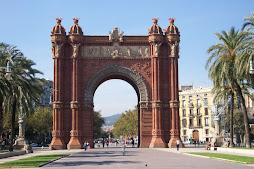
Prima porţiune a zidului a fost construită probabil în a doua jumătate a secolului V î.e.n. în timpul dezbinării Imperiului chinez (475 - 221 î.H ) cu scop de apărare împotriva nomazilor din nord.
In anul 214 î.H lasă împăratul Qin Shi Huangdi, să se construiască prima parte a zidului de la fluviul Galben ca apărare faţă de poporul nomad Xiongnu (numiţi în Europa huni).
Spre deosebire de zidul construit mai devreme care se întinde şi în văi, zidul acesta era construit numai pe crestele munţilor. Din lipsă de argilă s-a folosit la construcţia zidului numai piatră aşezată pe straturi.
Din acele timpuri zidul a fost mereu reclădit, atingând în timpul dinastiei Ming lungimea maximă. In anul 1493 a început împăratul Hongzhi construcţia zidului dinastiei Ming care servea ca apărare contra mongolilor şi pentru o supraveghere mai bună a drumurilor comerciale, ca porţiunea centrală a drumului mătăsii.
Pe crestele munţilor începându-se o construcţie deosebit de costisitoare.
Grosimea zidului este foarte diferită astfel de exemplu în regiunea Peking, zidul are o grosime între 4 şi 8 m, la coama zidului 8 iar la bază 10 m grosime, La intervale de câteva sute de metri s-au construit turnuri de 12 m înălţime cu rolul de observare, transmitere de signale şi depozit de arme.
Se apreciază ca ar fi existat aproximativ 25 000 de asemenea turnuri integrate în zid şi 15 000 de turnuri pentru signale care făceau legătura cu capitala situată lângă Kashgar.
Construcţie gigantică a lumii antice, Marele Zid Chinezesc măsoară după datele mai recente o lungime de 6 350 km, zidul principal având 2 400 km lungime., fiind şi astăzi “cel mai lung zid de pe Terra” (dupa cifrele date de oficialii chinezi ar avea 10.000 km).
Pentru a-şi proteja statul pe care îl unificase, primul împărat al Chinei, Qin (221-210 î.Hr.) porunceşte să fie legate între ele fortificaţii clădite de predecesorii săi.
În timpul următoarei dinastii, Han (206-220 i.Hr.), zidul a fost din nou prelungit spre est şi spre vest până la o lungime de 10.000 kilometri lungime (?).
Marele Zid Chinezesc a fost refăcut pe circa 6400 kilometri în timpul dinastiei Ming (1368-1644), dinastie ce a fixat şi capitala statului la Beijing (forma în care s-a păstrat până astăzi). Are o înălţime de 8 metri şi o lăţime de 6,5 metri. Pavat cu piatră, era folosit ca şosea strategică dar şi ca drum comercial.
sursa: wikipedia;
...alte bloguri :
http://food-and-nature.blogspot.com/
"http://patriarhii-ortodoxiei.blogspot.com/" http://romanianortodoxforathos.blogspot.com/








































_svg.png)









































